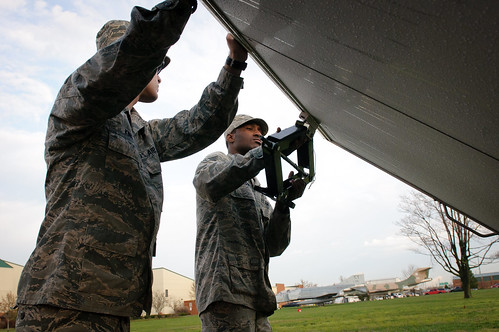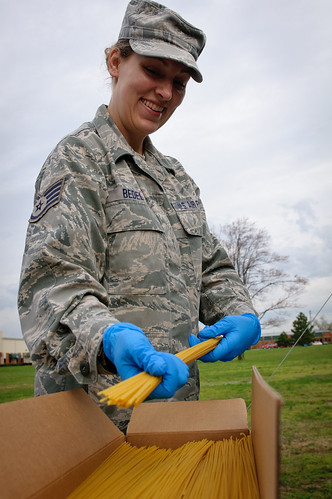Story by Master Sgt. Philip Speck, 123rd Airlift Wing Public Affairs
[caption id="" align="alignright" width="340"]

Airmen from the 123rd Force Support Squadron set up a new mobile field kitchen at the Kentucky Air National Guard Base in Louisville, Ky., on March 16, 2012. The kitchen can be deployed to the site of a natural disaster to provide hot meals for relief workers. (U.S. Air Force photo by Senior Airman Maxwell Rechel)
KENTUCKY AIR NATIONAL GUARD BASE, LOUISVILLE, Ky. -- Airmen at the Kentucky Air National Guard’s 123rd Airlift Wing recently evaluated a new military field kitchen to verify that the trailer-based unit can be transported easily aboard C-130 aircraft.
Formally known as the Disaster Relief Mobile Kitchen Trailer, the unit features all the equipment necessary to prepare and serve hot meals to relief workers in austere environments, said Bill Hague, senior food service advisor for Babington Technology, the North Carolina-based company that designed it. The kitchen is intended for rapid deployment to the scene of any major catastrophe like a hurricane or earthquake, he said.
Babington brought the kitchen to Louisville in March because of the 123rd Airlift Wing’s extensive experience supporting overseas deployments and disaster-response missions across the United States, according to Tech. Sgt. Aaron Foote, base services specialist for the 123rd Force Support Squadron. The Kentucky wing has one of only two Contingency Response Groups in the Air National Guard, dedicated to rapidly deploying to the scene of a disaster or attack, opening up non-functional airfields, and orchestrating the flow of air traffic so relief supplies can be flown in and casualties can be flown out.
To see more photos from this story, click here
[caption id="" align="alignleft" width="199"]

Senior Airman Amanda Bedel of the 123rd Force Support Squadron prepares to cook spaghetti during training on a new field kitchen at the Kentucky Air National Guard Base in Louisville, Ky., on March 16, 2012. The kitchen can be deployed to the site of a natural disaster to provide hot meals for relief workers. (U.S. Air Force photo by Senior Airman Maxwell Rechel)
The new kitchen differs from previous units in that food-service workers can begin preparing meals while the kitchen is still in transit, Hague said. That way, they can start serving meals as soon as the unit arrives at a disaster site. Older kitchens can take up to three hours to prepare food after their on-scene arrival.
“The DRMKT is the most rapidly responsive, capable field kitchen ever built for military applications,” Hague noted.
Robert Kaczorowski, functional area manager for services at the National Guard Bureau, said the new kitchen improves on current designs in another important way: Just about any food that can be procured on the local economy can be prepared and served. Older kitchens are designed to prepare only pre-packaged food called Unitized Group Rations.
Chief Master Sgt. Ray Dawson, air terminal superintendent for the 123rd Logistics Readiness Squadron here, and Tech. Sgt. Brian Milburn, a loadmaster for Kentucky’s 165th Airlift Squadron, evaluated the ease with which the kitchen could be loaded onto a C-130 and provided Hague with several suggestions for improvement to meet U.S. Air Force air-worthiness requirements.
Babington has been supplying military feeding equipment since 1995, Hague said. The first unit was the Marine Corps Tray Ration Heating System, followed by the Air Force Single Pallet Air Expeditionary Kitchen and the Army Assault Kitchen. After supporting relief operations during Hurricane Katrina, company engineers saw the limitations of existing mobile kitchens and decided to create the DRMKT.
Babington built its first prototype of the DRMKT four years ago, Hague said. The company has been testing it at disaster scenes ever since, the most recent being hurricane Irene in North Carolina, where the kitchen fed about 8,000 disaster victims.